スキルアップ研修3(2021.2.13)
![]()
潮岬灯台は、和歌山県串本町潮岬にある。
この灯台は、慶応2年(1866)江戸幕府が、イギリス、フランス、オランダ及びアメリカの4か国と締結した江戸条約で建設が決められた観音崎、釼埼、野島崎、神子元島、樫野崎、潮岬、伊王島及び佐多岬各灯台(八灯台)のうちの一つである。
当初のものは、英国人技師ヘンリーブラントンが設計し、明治2年(1869)4月着工し、明治3年6月に完成した。
明治3年6月10日に仮点灯を開始しており、日本初の洋式木造灯台である。
その後、明治6年9月15日に正式点灯して業務を開始した。
明治11年(1878)現在の石造りに改築された。
地上から構造物の頂部まで23mで、平均水面上から灯火までは49mである。
光度97万カンデラで、光達距離は19.0海里(約35㎞)である。
現在は、第5管区海上保安本部の田辺海上保安部が管理している。
Shionomisaki Lighthouse is located at Kushimoto Town in Wakayama prefecture.
This lighthouse is one of the main 8 lighthouses which were agreed to build
by the Edo Treaty in 1866.
The Edo Treaty was concluded between Japan and 4 countries (United Kingdom,
France, Holland and United States of America)
Original Lighthouse was designed by British
technical expert Henry Branton.
The construction started in April 1869 and
finished in June 1870.
The tentative lighting started on June 10,
1870.
That was the first wooden western style lighthouse
in Japan.
The official lighting started on September
15, 1873.
In 1878, the lighthouse was reconstructed
by stone.
It is 23 meters from the ground and 49
meters from the average water level to the top of the lighthouse.
It has a luminous intensity of 970,000
candelas and light reach of 19.0 nautical miles (about 35 km).
Currently it is managed by the Tanabe Coast
Guard Department of the 5th Regional Coast Guard Headquaters.
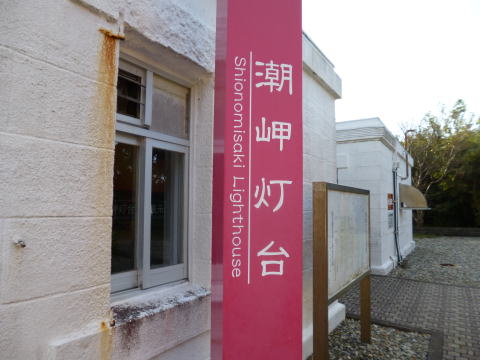
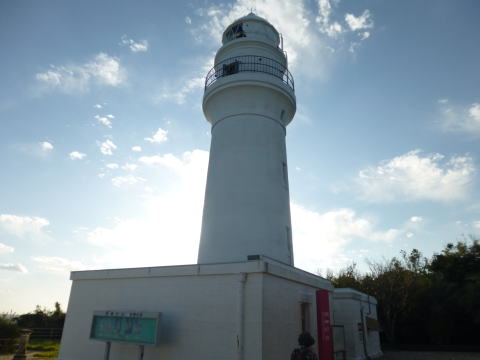

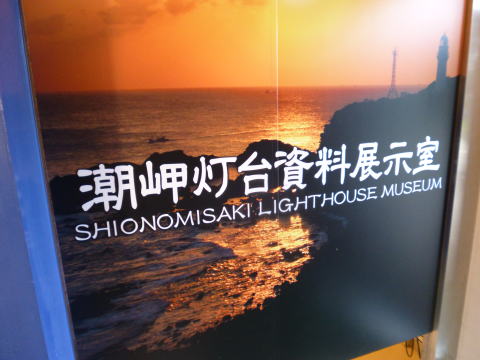
![]()
潮御崎神社は、和歌山県串本町潮岬にある神社である。
潮岬灯台の西にある静ケ峰に鎮座する。
祭神は、少彦名命(すくなひこなのみこと)である。
もとは、潮見の端に鎮座したが、明治3年(1870)に潮岬灯台が同地に設置されることとなり、現在地に移転した。
日本書紀の仁徳天皇三〇年九月一五日条によると、鎮座地一帯は、仁徳天皇皇后の磐之媛(いわのひめ)が、神事の酒宴に使う「御綱葉(みつなは)」(柏の葉)を採るため、紀国の熊野岬まで出かけたと記されている。
この話の熊野岬は、本州最南端の潮岬であるといわれており、潮御崎神社の入り口付近と拝殿前に、「御綱柏(みつなかしわ)」と呼ばれるマルバチシャが生えており、昭和56年6月1日に串本町の文化財に指定されている。
神社入り口には、花山法皇と白河天皇御製の石碑がある。

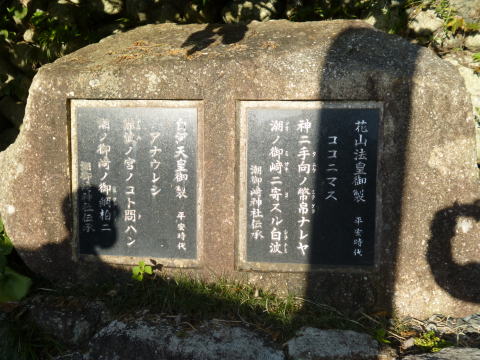
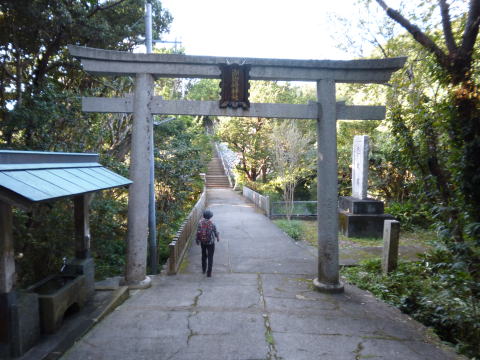

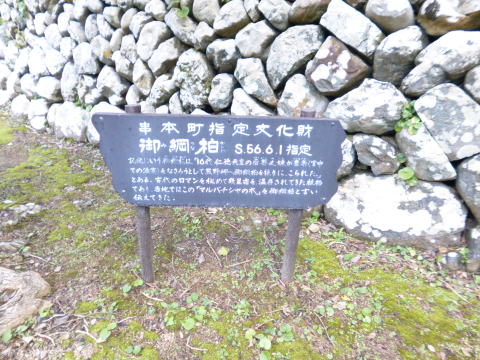
![]()
橋杭岩(はしぐいいわ)は、和歌山県串本町にある奇岩群である。
幅15m、長さ約900mにわたって橋脚のような巨岩が、串本から紀伊大島に向かってまっすぐに並んでいる。
これは、地下から上昇したマグマが泥岩層に入り込んで固まった後、やわらかい泥岩層が波に浸食され、かたい石英斑岩の部分だけがあたかも橋の杭だけが立っているように残ったものである。
海岸に散在している岩は、橋杭岩が壊れたかけらで、巨大地震による津波で陸側に運ばれたものと考えられている。
その昔、弘法大師と天邪鬼が賭けをして、天邪鬼に橋を架けさせたが、疲れた天邪鬼が鶏の声をまねて鳴いたため、大師は夜が明けたと勘違いし、橋造りを中止したという伝説も伝わっている。
橋杭岩は、吉野熊野国立公園内にあり、国の名勝、天然記念物に指定されている。
JR紀勢本線串本駅下車、徒歩20分。道の駅「くしもと橋杭岩」があり、無料駐車場を利用できる。
Hashigui-iwa Rocks is located in Kushimoto
Town, Wakayama Prefecture.
These massive strangely-shaped rocks are
lined up from Kushimoto to Kii Oshima island over a width of 15 meter and a length
of about 900 meter.
Hashigui-iwa literally means Bridge Pillar
Rocks, because they look like the pillars of a bridge.
The magma which rose from the underground entered
the mudstone layer and solidified, and then the soft mudstone layer was eroded
by the waves.
The hard quartz porphyry parts were left as
if only the bridge pillars were standing.
The rocks scattered along the coast are
fragments of Hashigui-iwa rocks, which are thought to have been carried to the land
by the tsunami caused by the great earthquake.
There is a legend about Hashigui-iwa rocks.
Kobo Daishi Kukai was a founder of Shingon
Esoteric Buddhism in the 9 th century.
Kobo Daishi and Amanojaku made a bet and
Kobo Daishi made Amanojaku build a bridge.
But Amanojaku tired very much and rang in
imitation of the voice of a chiken.
Therefore Kobo Daishi misunderstood that it
was dawn and stopped building the bridge.
Hashigui-iwa is located in the Yoshino Kumano National Park and is designated
as a national scenic spot and a natural monument.
It takes about 20 minutes from the
Kushimoto station of the JR Kisei Line.
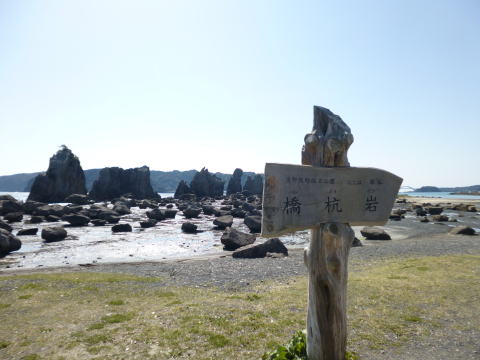
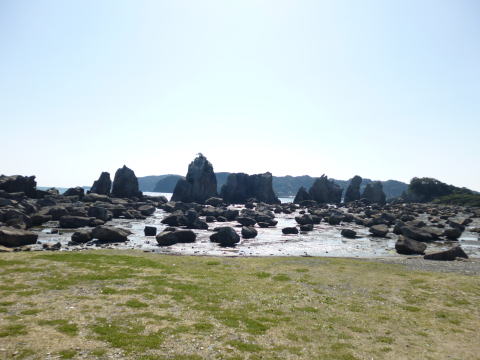

![]()
古座川の一枚岩は、和歌山県古座川町にある。
古座川の左岸にそびえる高さ100m、幅500mの大岩壁で、昭和16年に国の天然記念物に指定されている。
一枚岩は、「天柱岩」「飯盛岩」「ぼたん岩」「高地の虫喰岩」などの古座峡の奇岩とつながっている。
これらは熊野カルデラ火山の地下深くでマグマからできた岩体で「古座川弧状岩脈」と呼ばれている。
火山活動から長い年月を経て、地上に現れた岩体が風化、浸食されて珍しい形となった。
平成21年5月10日の「地質の日」に、紀伊半島の生い立ちを物語る貴重な地質遺産として、日本の地質百選に選定された。
JR古座駅から徒歩で約3時間。道の駅一枚岩があり、道の駅の駐車場を利用する。
→ フェニックス褶曲
The Ichimai-iwa of Kozagawa is located in Kozagawa Town, Wakayama Prefecture.
It is a large rock wall with a height of 100 meter and a width of 500 meter
that rises on the left side of the Koza river.
It was designated as a national natural monument in 1945.
The monolith is connected to the strange rocks of Kozakyo (ravine of the
Koza river) such as "Tentyuiwa", "Iimoriiwa", "Botan-iwa"
and "Mushikuiiwa in the highlands".
These are rock bodies made of magma deep underground in the Kumano caldera
volcanic and called "Kozagawa arc-shaped dikes"
Many years after the volcanic activity, the rock body that appeared on
the ground was weathered and eroded and became an unusual shape.
On May 10, 2009, "Geological Day", it was selected as one of
the 100 Geological Selections in Japan as a valuable geological heritage
that shows the story of the origin of Kii Peninsula.
It takes about 3 hours on foot from JR Koza station. There is a roadside
station Ichimai-iwa and the parking lot.
![]()
昔、太地(今の太地町)にいた岩が大好きな魔物が、古座川に目をつけ、下流の岩から次々と食べていった。
いよいよ一枚岩を食べようと噛みついた時、里に住む猟犬が襲いかかった。
魔物は、犬が大嫌いだったので一目散に退散した。お蔭で一枚岩とその上流の岩は食べられずに残っているという。
4月19日前後と8月25日前後の夕方5時前の数分間、夕日を受けて犬の形をした影が一枚岩に浮かび上がる。
地元では、親しみを込めて「一枚岩の守り犬」と呼ばれている。
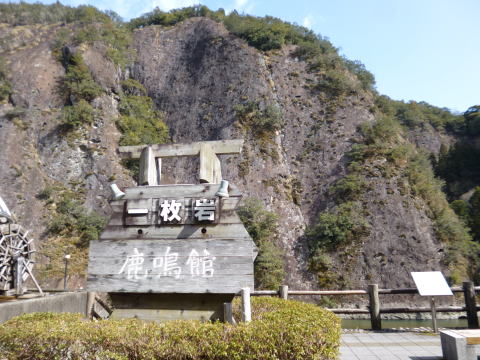
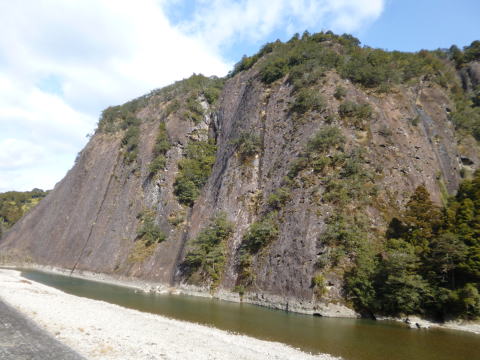
![]()
フェニックス褶曲(フェニックスクリフ)は、和歌山県すさみ町口和深きさば海岸にある。
褶曲は、堆積した当時は水平だった地層が地殻変動などで横からの力が加わり波状などに屈曲した状態をいう。
この褶曲は、二千万年前から四千万年前にかけて形成されたと言われ、「つの字」「くの字」型に大きく折れ曲がり、木の年輪状の断面を見ることができ、南紀熊野ジオパークの一部である。
南紀熊野では、プレートの沈み込みに伴って生み出された下記の異なる三つの地質体を見ることができる。
| 付加体 | 深い海にたまった砂や泥が陸地に押し付けられてできた岩石 | フェニックス褶曲 | |
| 前弧海盆堆積体 | 浅い海にたまった砂や泥が固まった岩石 | 千畳敷 | |
| 火成岩体 | マグマが冷えて固まった岩石 | 古座川の一枚岩 |
南紀熊野ジオパークセンター(TEL0735-67-7100)にガイドを申し込むことができる。
紀勢本線周参見駅下車、徒歩約1時間。国道42号線沿いに数台の駐車スペースがある。危険度が高いため、登山靴等で行く必要がある。潮位が高い時には見学できない。
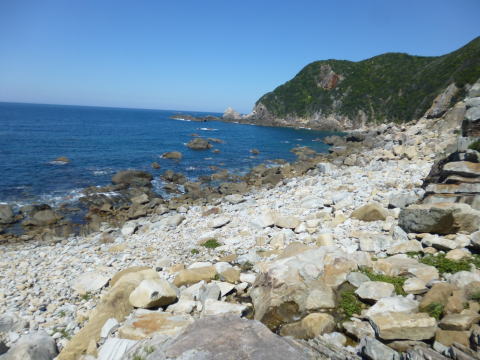


![]()
千畳敷は、和歌山県白浜町にある名勝である。
白浜町瀬戸崎の太平洋に突き出た広大なスロープ性砂岩の大岩盤である。
このデコボコの岩盤は、第3紀層のやわらかい砂岩が、打ち寄せる荒波に長い間浸食されてできたものである。
風の強い日は、波が岩に砕け散って勇壮な光景を見せる。
三段壁とともに白浜を代表する雄大な景勝地で、和歌山県朝日夕陽百選の碑が建てられている。
JRきのくに線白浜駅からバスで「千畳敷」下車。無料駐車場がある。

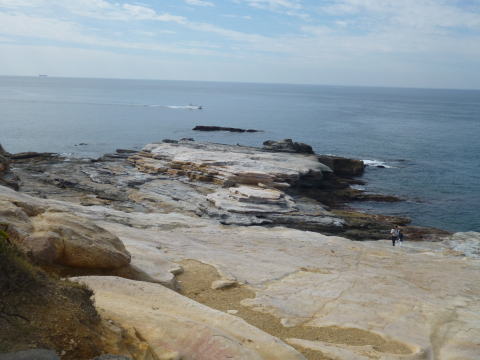

TOP PAGE 観光カレンダー
TOP PAGE 观光最佳时期